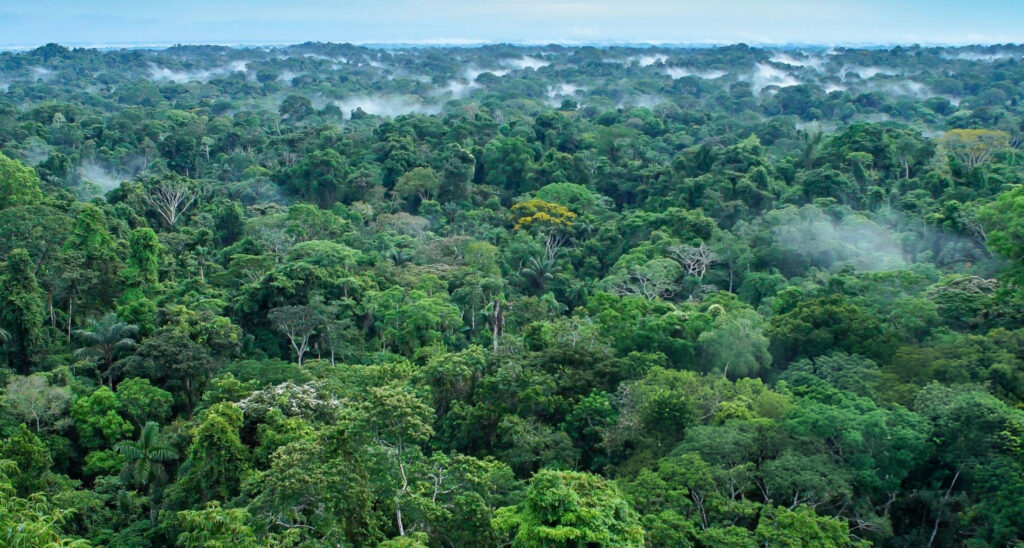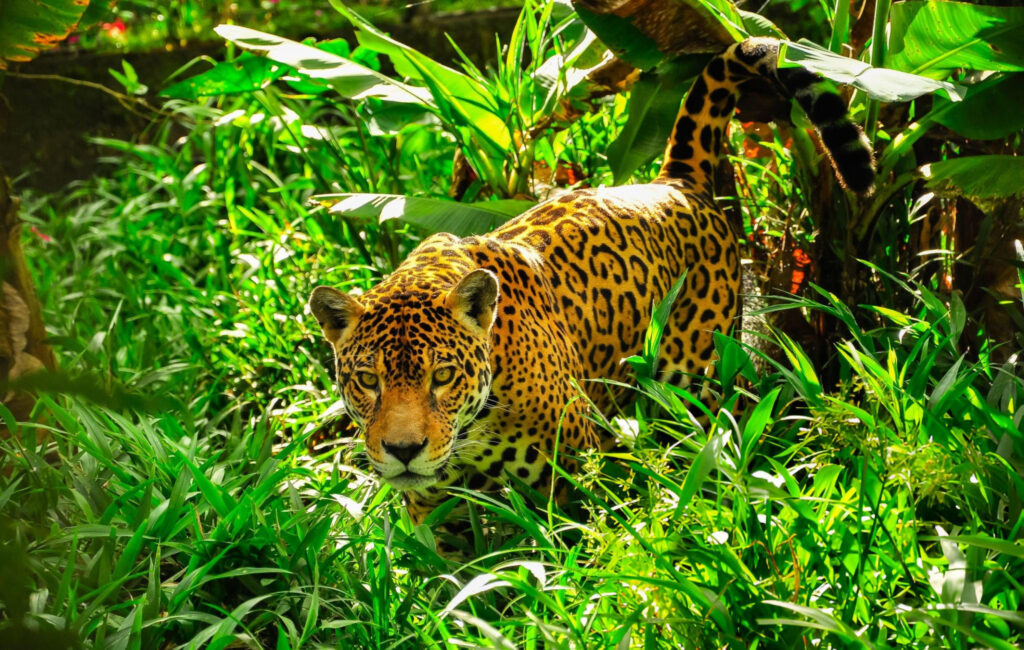Have you ever wondered about the secrets in the Amazon Rainforest? This huge, green area is the biggest tropical rainforest in the world. It’s full of life, amazing plants, and animals that have fascinated people for ages. The Amazon is key to understanding our planet and protecting our home for the future.
What makes the Amazon so special? This article will show you the secrets of this green treasure. You’ll learn about the many plants and animals that live here and the people who have lived here for thousands of years. Get ready to be amazed by the Amazon’s size and complexity. And learn about the big challenges it faces today.
Key Takeaways
- The Amazon Rainforest is the world’s largest tropical rainforest, spanning multiple countries in South America.
- It is home to an incredibly diverse array of plant and animal species, many of which are yet to be discovered.
- The Amazon plays a vital role in regulating the global climate, serving as a massive carbon sink and producer of oxygen.
- Indigenous communities have lived in the Amazon for thousands of years, maintaining a deep connection to the land and its resources.
- Deforestation and habitat loss pose significant threats to the Amazon’s delicate ecosystems, with far-reaching consequences for the planet.
The Amazon Rainforest: A Verdant Treasure Trove
The tropical rainforests of the Amazon stretch across nine countries. They cover about 40% of South America, making it the largest tropical ecosystem in the world. This area is a true biodiversity hotspot, filled with a wide variety of plants and animals.
The Amazon is home to around 390 billion trees, with about 16,000 different species. It’s a paradise for many flora and fauna, including mammals, birds, reptiles, amphibians, and insects found only here. This tropical ecosystem is crucial for the global climate and supports local communities through sustainable forestry and conservation efforts.
“The Amazon is the world’s largest tropical rainforest, a true wonder of nature that must be preserved for future generations.”
The Amazon faces many dangers, like deforestation, habitat loss, and climate change. But, thanks to environmental activism and sustainable forestry, there’s hope to save this precious biodiversity hotspot for the future.
| Fact | Statistic |
|---|---|
| Size of the Amazon Rainforest | Approximately 2.1 million square miles (5.5 million square kilometers) |
| Number of Tree Species | Estimated 16,000 different species |
| Percentage of South America Covered | Around 40% |
| Number of Mammal Species | Over 400 different species |
Exploring the Biodiversity Hotspot
The Amazon Rainforest is a true marvel of nature. It boasts an incredible diversity of plant and animal life. This verdant tropical ecosystem is home to an estimated 10 million different species. It’s one of the most biodiverse regions on the planet.
From the towering canopy to the forest floor, the Amazon is teeming with unique and interconnected habitats. These habitats support a remarkable array of tropical flora and fauna.
Countless Species of Flora and Fauna
The Amazon Rainforest is a tropical rainforest unlike any other. It hosts a remarkable array of plants and animals. Iconic creatures like jaguars, giant otters, and the elusive jaguar call this place home.
The lush tropical climate also supports a staggering diversity of birds, reptiles, amphibians, and insects. Many of these species have yet to be fully documented by scientists.
Unique Ecosystems and Habitats
The Amazon Rainforest is a mosaic of diverse and interconnected ecosystems. Each supports a unique array of tropical flora and fauna. From the flooded forests of the varzea to the nutrient-poor soils of the terra firme, the Amazon is home to a variety of distinct habitats.
This remarkable rainforest ecology is a testament to the resilience and adaptability of life in this verdant treasure trove. The Amazon’s tropical climate has allowed these habitats to thrive.
| Ecosystem | Characteristics | Dominant Species |
|---|---|---|
| Varzea | Seasonally flooded forests | Giant river otters, pink dolphins, manatees |
| Terra Firme | Nutrient-poor, well-drained upland forests | Jaguar, puma, harpy eagle |
| Igapo | Permanently flooded forests | Giant arapaima fish, black caiman, hoatzin |

“The Amazon Rainforest is the most biodiverse place on Earth, home to an astonishing array of life that continues to captivate and inspire us.”
The Indigenous Peoples of the Amazon
Deep in the Amazon Rainforest, many indigenous communities live. They have been here for centuries. Each group has its own culture, traditions, and ways of living sustainably.
These communities are the Amazon’s true protectors. Their knowledge and care have kept the rainforest alive. It’s a key place for biodiversity and helps fight climate change.
Groups like the Yanomami in Brazil and Venezuela, and the Achuar in Ecuador and Peru, live in harmony with nature. They manage resources well and keep a balance between humans and nature. Their love for the Amazon shows how important it is to save it.
As we learn to value the Amazon, the role of these communities grows. They help protect the forest through tourism and conservation efforts. Their knowledge and care are crucial for the future.
“The Amazon Rainforest is not just our home, but the heart and soul of our people. We are its protectors, and we will continue to defend it with our very lives.”

| Indigenous Group | Location | Population | Traditional Practices |
|---|---|---|---|
| Yanomami | Brazil, Venezuela | 27,000 | Subsistence farming, hunting, and gathering |
| Achuar | Ecuador, Peru | 6,000 | Sustainable resource management, traditional medicine |
| Kayapo | Brazil | 9,000 | Agroforestry, forest conservation, ecotourism |
Amazon Rainforest
The Amazon rainforest is a vast and remarkable ecosystem in South America. It covers over 2.1 million square miles. It’s the world’s largest tropical rainforest and key to the global climate.
Spanning Multiple Countries
The Amazon rainforest stretches across nine countries. These include Brazil, Peru, Colombia, Ecuador, Venezuela, Guyana, Suriname, French Guiana, and Bolivia. This area is full of lush foliage and home to many plants and animals, with some still undiscovered.
A Vital Carbon Sink
The Amazon rainforest is crucial for our planet. It acts as a vital carbon sequestration system. The trees and plants absorb and store a lot of carbon dioxide, helping to control the climate.
This tropical rainforest is vital for ecosystem conservation. Its preservation is key for the planet’s health.

“The Amazon rainforest is not only the lungs of our planet, but it is also the heart and soul of our global ecosystem. Its conservation is vital for the future of our planet.”
Threats to the Rainforest
The Amazon Rainforest is a green wonder of the world. It faces many threats that harm its ecosystems and the people who live there. The main threats are illegal logging and tropical deforestation, which have destroyed a lot of this valuable area.
Deforestation and Habitat Loss
Things like growing more crops, mining, and building more places to live have hurt the Amazon’s forests. This habitat loss hurts the many plants and animals that live there. It also makes climate change impacts worse, which is a big problem for the whole tropical ecosystem.
- Illegal logging is a big problem, with criminals taking the rainforest’s resources for themselves.
- More crops and cattle ranching have taken over a lot of the Amazon.
- Mining, both legal and illegal, has also damaged the area and upset the balance of nature.
The loss of the Amazon Rainforest is a big danger to the unique animals and plants that live there. It also threatens the way of life of the indigenous people who have always taken care of it. We need to act fast to save this important natural resource.
“The Amazon Rainforest is not just a habitat for countless species – it is the lungs of our planet, a crucial carbon sink that helps regulate the global climate. Its destruction has far-reaching consequences that we cannot afford to ignore.”
Sustainable Ecotourism in the Amazon
The Amazon Rainforest is a green treasure full of life. It gives visitors a chance to see the beauty of eco-tourism. Eco-tourism helps keep the tropical rainforest safe and supports the people who live there.
Ecotourism in the Amazon is more than just looking around. It’s about diving into the area’s culture and delicate nature. Visitors can do things like go on hikes, watch birds, and explore rivers.
These green tourism ways help save the Amazon Rainforest and help local people. By working with eco-tourism groups, these communities can share their traditions. They can also earn money to keep their culture alive.
| Ecotourism Activities | Benefits |
|---|---|
| Guided Hikes | Explore the diverse ecosystems, observe wildlife, and learn about the forest’s ecology |
| Birdwatching | Spot unique avian species and contribute to conservation efforts |
| River Excursions | Discover the Amazon River and its surrounding habitats, while supporting sustainable forestry initiatives |
By choosing eco-tourism in the Amazon, we help save this amazing place. We can all help protect the Amazon Rainforest and its people by exploring carefully.
“The Amazon Rainforest is not just a place of beauty, but a testament to the resilience and fragility of our planet. Ecotourism offers a way for us to connect with this remarkable ecosystem while ensuring its preservation for the future.”
The Amazon River: Lifeblood of the Rainforest
The Amazon River is the heart and soul of the tropical rainforests it supports. This massive river, over 4,000 miles long, is essential for life in the Amazon basin. It provides water and is a key route for travel, making it the lifeblood of the rainforest ecology.
Exploring the Amazon’s Wonders
Traveling the Amazon River is an immersive adventure in the tropical rainforests. You’ll see stunning landscapes full of plants and animals. It’s a chance to learn about the complex life in this natural wonder.
- Spot a wide array of vibrant bird species, from the iconic macaws to the elusive harpy eagles.
- Observe the graceful movements of river dolphins and the powerful presence of giant otters.
- Explore the serene tributaries and discover hidden pockets of the rainforest ecology.
The Amazon River is more than just a waterway. It shows the amazing diversity and strength of the tropical rainforests it supports.
“The Amazon River is the lifeblood that nourishes the world’s largest and most biodiverse tropical rainforest.” – Jane Goodall, renowned primatologist and conservationist
As we travel the Amazon’s winding paths, we see its importance. The Amazon River and its ecosystem are crucial for local people and the planet. Seeing this rainforest ecology up close is a life-changing experience. It teaches us to value the Amazon’s unique worth.
Conservation and Preservation Efforts
Keeping the Amazon Rainforest safe is key for our planet and its creatures. The Nature Conservancy works with local groups and governments. They use sustainable forestry and protect areas to keep the Amazon’s balance.
The Rainforest Trust helps indigenous communities in the Amazon. They give resources and training to protect their lands. This helps keep the rainforest’s biodiversity safe.
The World Wildlife Fund (WWF) fights deforestation in the Amazon. They work with companies, governments, and groups to plant trees and support green farming. These actions help the Amazon stay a vital carbon sink and protect its ecosystems.

